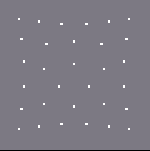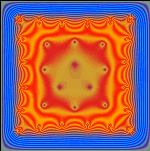Overview
SimSurface might best be described as a "what-if tool." It is not designed
to lead a student through an artificial,
preprogrammed "experiment"; rather, it allows the student to have an authentic
scientific experience. The process of observation, conjecture, and testing of conjectures
(by experimentation and, of course, more observation) is what real scientists do
every day. Our hope is that students will find enough interesting questions to ask about
the events they observe when using SimSurface to reawaken the innate curiosity that we
have as children and which is the real driving force behind most scientific inquiry.
SimSurface
is a program designed for use in instruction of computational science in
general and of the specific numerical techniques used in the program.
SimSurface demonstrates two commonly used computational techniques. The first, simulated
annealing, is an often-used method for finding global maxima and minima of
complicated multi-dimensional functions. It can be used any time you have
a function that gets big when things are bad and small when things are
good (or vice-versa). The problem being solved in SimSurface is a minimization
of potential energy. The question we are trying to answer is: given
n
stationary electrons/protons confined to a 2-dimensional surface by four
charged walls, what arrangement of electrons has the minimum total energy and
is therefore the configuration preferred by nature?
If the user chooses to experiment with the "Application" part of Simsurface,
he enters numbers
that specify the initial conditions of the surface and electrons (number of
electrons and the charge values on the walls).
If instead he chooses to experiment with the "Algorithm" section of Simsurface,
he is prompted for values which determine how fast the system cools.
The "Architecture" section of SimSurface is not yet functional: the code
can only be run on one machine, in this case an SGI Power Challenge.

Typical initial configuration
| 
Typical final configuration
|
Once the system has reached a minimum energy (to within a specified tolerance),
we would like to know what the electrical potential looks like around the
electrons.
This could of course just be calculated directly at each point,
but a much faster and widely used technique called relaxation is actually
used to solve Laplace's equation. Laplace's equation says that the net
curvature of the potential surface is zero everywhere (del^2 phi=0) on the
surface (except at the point charges themselves), but the relaxation
method is very easy to understand, even for those that do not fully
understand
the equation it is solving. It is an iterative process, which at each
iteration sets the value of a grid point equal to the average of its 4
neighbors. The charges and walls are held constant throughout this
process. SimSurface displays the end result of this process: the
potential on the plate.

Note that the colored bands in the image are
equipotential lines of the field.
[ Home | SimSurface Home | Index ]
[ Introduction | Instructional Resources | Simulation Software | SimSurface Help ]
[ Fractal Modeling
Tools | Baroreceptor Modeling | GalaxSee ]
[ Gnuplot | The Pit and the
Pendulum | Environmental Models | InteGreat ]
Please direct questions and comments about this page to WebMaster@shodor.org
© Copyright 1994-2006 The Shodor Education Foundation, Inc.